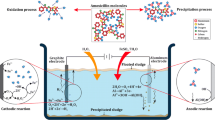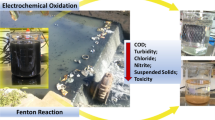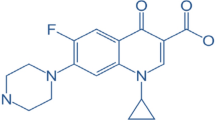Abstract
The current work deals with efficient removal of acetaminophen (AC) from hospital wastewater using electro-Fenton (EF) process. The degradation yield of 99.5% was obtained under optimal experimental conditions, namely 5.75 mg L−1 initial AC concentration, 2.75 pH solution, 3-cm inter-electrode distance, 100 mg L−1 KCl electrolyte, 122.5 µL L−1 H2O2, 8 mA cm−2 current density at equilibrium time of 8 min. Analysis of variance (ANOVA) suggested that the effect of mentioned operating parameters was statistically significant on the AC removal. The low probability amount of P value (P < 0.0001), the Fisher’s F-value of 65.91, and correlation coefficient of the model (R2 = 0.9545) revealed a satisfactory correlation between the experimental and the predicted values of AC removal. The predicted removal efficiency of 99.4% was in satisfactory agreement with the obtained experimental removal efficiency of 98.7%. The AC degradation during the EF followed a first-order kinetic model with rate constants (Kapp) of 0.6718 min−1. Using the ordinary radical scavengers revealed that main mechanism of AC degradation controlled by the hydroxyl free radicals produced throughout the EF process. The excess amount of iron (II) scavenged the active radicals and diminished the concentration of ·OH available to react with AC. The optimum molar ratio of H2O2 to Fe2+ was found to be 2.5. The developed EF process as a promising technique applied for treatment of real samples.









Similar content being viewed by others
References
Abdessalem AK, Bellakhal N, Oturan N, Dachraoui M, Oturan MA (2010) Treatment of a mixture of three pesticides by photo-and electro-Fenton processes. Desalination 250:450–455
Abdullah N, Fulazzaky MA, Yong EL, Yuzir A, Sallis P (2016) Assessing the treatment of acetaminophen-contaminated brewery wastewater by an anaerobic packed-bed reactor. J Environ Manag 168:273–279
Ahmadzadeh S, Kassim A, Rezayi M, Abdollahi Y, Hossein G (2011a) A conductometric study of complexation reaction between meso-octamethylcalix [4] pyrrole with titanium cation in acetonitrile-ethanol binary mixtures. Int J Electrochem Sci 6:4749–4759
Ahmadzadeh S, Kassim A, Rezayi M, Rounaghi GH (2011b) Thermodynamic study of the complexation of p-Isopropylcalix [6] arene with Cs + cation in dimethylsulfoxide-acetonitrile binary media. Molecules 16:8130–8142
Ahmadzadeh S, Rezayi M, Faghih-Mirzaei E, Yoosefian M, Kassim A (2015a) Highly selective detection of titanium (III) in Industrial waste water samples using meso-octamethylcalix [4] pyrrole-doped PVC membrane ion-selective electrode. Electrochim Acta 178:580–589
Ahmadzadeh S, Rezayi M, Karimi-Maleh H, Alias Y (2015b) Conductometric measurements of complexation study between 4-Isopropylcalix [4] arene and Cr 3 + cation in THF-DMSO binary solvents. Measurement 70:214–224
Ahmadzadeh S, Rezayi M, Kassim A, Aghasi M (2015c) Cesium selective polymeric membrane sensor based on p-isopropylcalix [6] arene and its application in environmental samples RSC. Advances 5:39209–39217
Ahmadzadeh S, Asadipour A, Pournamdari M, Behnam B, Rahimi HR, Dolatabadi M (2017) Removal of ciprofloxacin from hospital wastewater using electrocoagulation technique by aluminum electrode: optimization and modelling through response surface methodology. Process Saf Environ Prot 109:538–547. https://doi.org/10.1016/j.psep.2017.04.026
Babuponnusami A, Muthukumar K (2012) Advanced oxidation of phenol: a comparison between Fenton, electro-Fenton, sono-electro-Fenton and photo-electro-Fenton processes. Chem Eng J 183:1–9
Bedner M, MacCrehan WA (2006) Transformation of acetaminophen by chlorination produces the toxicants 1, 4-benzoquinone and N-acetyl-p-benzoquinone imine. Environ Sci Technol 40:516–522
Camacho-Muñoz D, Martín J, Santos JL, Aparicio I, Alonso E (2009) An affordable method for the simultaneous determination of the most studied pharmaceutical compounds as wastewater and surface water pollutants. J Sep Sci 32:3064–3073
Coimbra R, Escapa C, Paniagua S, Otero M (2016) Adsorptive removal of diclofenac from ultrapure and wastewater: a comparative assessment on the performance of a polymeric resin and activated carbons. Desalin Water Treat 57:27914–27923
de Luna MDG, Veciana ML, Su C-C, Lu M-C (2012) Acetaminophen degradation by electro-Fenton and photoelectro-Fenton using a double cathode electrochemical cell. J Hazard Mater 217:200–207
Doltabadi M, Alidadi H, Davoudi M (2016) Comparative study of cationic and anionic dye removal from aqueous solutions using sawdust-based adsorbent. Environ Prog Sustain Energy 35:1078–1090
Estrada AL, Li Y-Y, Wang A (2012) Biodegradability enhancement of wastewater containing cefalexin by means of the electro-Fenton oxidation process. J Hazard Mater 227:41–48
Farré M, Kantiani L, Petrovic M, Pérez S, Barceló D (2012) Achievements and future trends in the analysis of emerging organic contaminants in environmental samples by mass spectrometry and bioanalytical techniques. J Chromatogr A 1259:86–99
Fouladgar M, Ahmadzadeh S (2016) Application of a nanostructured sensor based on NiO nanoparticles modified carbon paste electrode for determination of methyldopa in the presence of folic acid. Appl Surf Sci 379:150–155
Fulazzaky MA, Majidnia Z, Idris A (2017) Mass transfer kinetics of Cd (II) ions adsorption by titania polyvinylalcohol-alginate beads from aqueous solution. Chem Eng J 308:700–709
Ganesan P, Kamaraj R, Vasudevan S (2013) Application of isotherm, kinetic and thermodynamic models for the adsorption of nitrate ions on graphene from aqueous solution. J Taiwan Inst Chem Eng 44:808–814
Groeschke M, Kumar P, Winkler A, Grützmacher G, Schneider M (2016) The role of agricultural activity for ammonium contamination at a riverbank filtration site in central Delhi (India). Environ Earth Sci 75:129
Guivarch E, Trevin S, Lahitte C, Oturan MA (2003) Degradation of azo dyes in water by electro-Fenton process. Environ Chem Lett 1:38–44
Jung C, Oh J, Yoon Y (2015) Removal of acetaminophen and naproxen by combined coagulation and adsorption using biochar: influence of combined sewer overflow components. Environ Sci Pollut Res 22:10058–10069
Kamaraj R, Vasudevan S (2016) Facile one-pot synthesis of nano-zinc hydroxide by electro-dissolution of zinc as a sacrificial anode and the application for adsorption of Th4+, U4+, and Ce4 + from aqueous solution. Res Chem Intermed 42:4077–4095
Kamaraj R, Pandiarajan A, Jayakiruba S, Naushad M, Vasudevan S (2016) Kinetics, thermodynamics and isotherm modeling for removal of nitrate from liquids by facile one-pot electrosynthesized nano zinc hydroxide. J Mol Liq 215:204–211
Kassim A et al (2011) A Novel ion selective polymeric membrane sensor for determining thallium (I) with high selectivity. In: IOP conference series: materials science and engineering. IOP Publishing, p 012010
Khandegar V, Saroha AK (2013) Electrocoagulation for the treatment of textile industry effluent—a review. J Environ Manag 128:949–963
Klamerth N, Malato S, Agüera A, Fernández-Alba A (2013) Photo-Fenton and modified photo-Fenton at neutral pH for the treatment of emerging contaminants in wastewater treatment plant effluents: a comparison. Water Res 47:833–840
Moussavi G, Aghanejad M (2014) The performance of electrochemical peroxidation process for COD reduction and biodegradability improvement of the wastewater from a paper recycling plant. Sep Purif Technol 132:182–186
Moussavi G, Bagheri A, Khavanin A (2012) The investigation of degradation and mineralization of high concentrations of formaldehyde in an electro-Fenton process combined with the biodegradation. J Hazard Mater 237:147–152
Nidheesh P, Gandhimathi R (2012) Trends in electro-Fenton process for water and wastewater treatment: an overview. Desalination 299:1–15
Panizza M, Oturan MA (2011) Degradation of Alizarin Red by electro-Fenton process using a graphite-felt cathode. Electrochim Acta 56:7084–7087
Pardakhty A, Ahmadzadeh S, Avazpour S, Gupta VK (2016) Highly sensitive and efficient voltammetric determination of ascorbic acid in food and pharmaceutical samples from aqueous solutions based on nanostructure carbon paste electrode as a sensor. J Mol Liq 216:387–391
Rezayi M, Karazhian R, Abdollahi Y, Narimani L, Sany SBT, Ahmadzadeh S, Alias Y (2014) Titanium (III) cation selective electrode based on synthesized tris (2pyridyl) methylamine ionophore and its application in water samples. Sci Rep 4:0000–0025
Rounaghi G, Mohajeri M, Ahmadzadeh S, Tarahomi S (2009) A thermodynamic study of interaction of Na + cation with benzo-15-crown-5 in binary mixed non-aqueous solvents. J Incl Phenom Macrocycl Chem 63:365–372
Sirés I, Arias C, Cabot PL, Centellas F, Rodríguez RM, Garrido JA, Brillas E (2004) Paracetamol mineralization by advanced electrochemical oxidation processes for wastewater treatment. Environ Chem 1:26–28
Soltani H, Pardakhty A, Ahmadzadeh S (2016) Determination of hydroquinone in food and pharmaceutical samples using a voltammetric based sensor employing NiO nanoparticle and ionic liquids. J Mol Liq 219:63–67
Su C-C, Chang A-T, Bellotindos LM, Lu M-C (2012) Degradation of acetaminophen by Fenton and electro-Fenton processes in aerator reactor Separation and purification technology 99:8–13
Venkatkarthick R, Kiruthika GVM, Davidson DJ, Ravichandran S, Sozhan G, Vasudevan S (2016) New insight into understand the enhanced photoconductivity properties of Ti (O2) plate spurted with Al2O3 for water oxidation. Chem Select 1:5037–5041
Wang N, Zheng T, Zhang G, Wang P (2016) A review on Fenton-like processes for organic wastewater treatment Journal of Environmental. Chem Eng 4:762–787
Yahya MS, Oturan N, El Kacemi K, El Karbane M, Aravindakumar C, Oturan MA (2014) Oxidative degradation study on antimicrobial agent ciprofloxacin by electro-fenton process: kinetics and oxidation products. Chemosphere 117:447–454
Yoosefian M, Ahmadzadeh S, Aghasi M, Dolatabadi M (2017) Optimization of electrocoagulation process for efficient removal of ciprofloxacin antibiotic using iron electrode; kinetic and isotherm studies of adsorption. J Mol Liq 225:544–553. https://doi.org/10.1016/j.molliq.2016.11.093
Zhao X, Zhang B, Liu H, Chen F, Li A, Qu J (2012) Transformation characteristics of refractory pollutants in plugboard wastewater by an optimal electrocoagulation and electro-Fenton process. Chemosphere 87:631–636
Acknowledgements
The authors express their appreciation to Neuroscience Research Center and Pharmaceutics Research Center both affiliated to Institute of Neuropharmacology, Kerman University of Medical Sciences, Kerman, Iran, for supporting the current work.
Author information
Authors and Affiliations
Corresponding author
Rights and permissions
About this article
Cite this article
Ahmadzadeh, S., Dolatabadi, M. Removal of acetaminophen from hospital wastewater using electro-Fenton process. Environ Earth Sci 77, 53 (2018). https://doi.org/10.1007/s12665-017-7203-7
Received:
Accepted:
Published:
DOI: https://doi.org/10.1007/s12665-017-7203-7




